Livestock
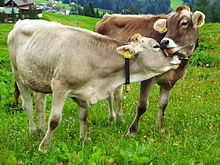

Livestock are the
The breeding, maintenance, slaughter and general subjugation of livestock, called
Livestock farming practices have largely shifted to intensive animal farming.[4] Intensive animal farming increases the yield of the various commercial outputs, but also negatively impacts animal welfare, the environment, and public health.[5] In particular, beef, dairy and sheep are an outsized source of greenhouse gas emissions from agriculture.
Etymology
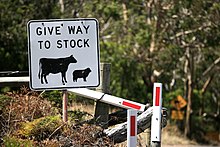
The word livestock was first used between 1650 and 1660, as a
United States federal legislation defines the term to make specified agricultural commodities eligible or ineligible for a program or activity. For example, the Livestock Mandatory Reporting Act of 1999 (P.L. 106–78, Title IX) defines livestock only as cattle, swine, and sheep, while the 1988 disaster assistance legislation defined the term as "cattle, sheep, goats, swine, poultry (including egg-producing poultry), equine animals used for food or in the production of food, fish used for food, and other animals designated by the Secretary".[8]
Deadstock is defined in contradistinction to livestock as "animals that have died before slaughter, sometimes from illness or disease". It is illegal in many countries, such as Canada, to sell or process meat from dead animals for human consumption.[9]
History
Animal-rearing originated during the cultural transition to settled farming communities from hunter-gatherer lifestyles. Animals are domesticated when their breeding and living conditions are controlled by humans. Over time, the collective behaviour, lifecycle and physiology of livestock have changed radically. Many modern farmed animals are unsuited to life in the natural world.
Types
The term "livestock" is indistinct and may be defined narrowly or broadly. Broadly, livestock refers to any population of animals kept by humans for a useful, commercial purpose.
| Animal | Ancestor | Domestication | Utilization | Picture |
|---|---|---|---|---|
| Horse | Tarpan | Eurasia | Riding, racing, carrying and pulling loads, meat, milk | 
|
| Donkey | African wild ass | Africa | Carrying loads and draught | 
|
| Cattle | Eurasian aurochs
|
Eurasia | Meat, milk and draught | 
|
| Zebu | Indian aurochs | Eurasia | Milk, meat and draught | 
|
| Bali cattle | Banteng | SE Asia | Meat, milk and draught | 
|
| Yak | Wild yak | Tibet | Pack animals, milk, meat and hide | 
|
| Water buffalo | Wild water buffalo | India and SE Asia | Meat, milk and carrying loads | 
|
| Gayal | Gaur | India and Malaysia | Carrying loads and draught | 
|
| Sheep | Mouflon | Iran and Asia Minor | Meat, milk and fleece. | 
|
| Goat | Bezoar ibex | Greece and Pakistan | Meat, milk and fleece | 
|
| Reindeer | Reindeer | Eurasia | Draught, milk, flesh and hide | 
|
| Bactrian camel | Wild Bactrian camel | Central Asia | Riding, racing, meat, milk and fur | 
|
| Arabian camel | Thomas' camel | North Africa and SW Asia | Riding, racing, meat and milk | 
|
| Llama | Guanaco | Andes | Pack animals, meat, fleece | 
|
| Alpaca | vicuña | Andes | Meat, fleece | 
|
Domestic Pig
|
Wild boar | Eurasia | Meat | 
|
| Chicken | red junglefowl | Southeast Asia | Meat, egg | 
|
| Rabbit | European rabbit | Europe | Meat, wool | 
|
| Guinea pig | Montane guinea pig | Andes | Meat |  fornite fornite
|
Micro-livestock
Micro-livestock is the term used for much-smaller animals, usually mammals. The two predominant categories are
Farming practices
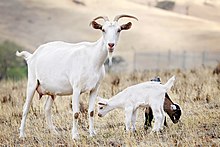
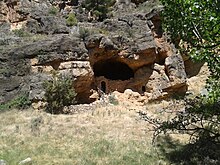
Traditionally, animal husbandry was part of the
In the traditional system of
Animals can be kept extensively or intensively. Extensive systems involve animals roaming at will, or under the supervision of a herdsman, often for their protection from predators. Ranching in the Western United States involves large herds of cattle grazing widely over public and private lands.[19] Similar cattle stations are found in South America, Australia and other places with large areas of land and low rainfall. Ranching systems have been used for sheep, deer, ostrich, emu, llama and alpaca.[20] In the uplands of the United Kingdom, sheep are turned out on the fells in spring and graze the abundant mountain grasses untended, being brought to lower altitudes late in the year, with supplementary feeding being provided in winter.[21]
In rural locations, pigs and poultry can obtain much of their nutrition from scavenging, and in African communities, hens may live for months without being fed, and still produce one or two eggs a week.[17] At the other extreme, in the more Western parts of the world, animals are often intensively managed; dairy cows may be kept in zero-grazing conditions with all their forage brought to them; beef cattle may be kept in high density feedlots;[22] pigs may be housed in climate-controlled buildings and never go outdoors;[23] poultry may be reared in barns and kept in cages as laying birds under lighting-controlled conditions. In between these two extremes are semi-intensive, often family-run farms where livestock graze outside for much of the year, silage or hay is made to cover the times of year when the grass stops growing, and fertiliser, feed and other inputs are bought onto the farm from outside.[24]
Predation
Livestock farmers have often dealt with
Disease
Good husbandry, proper feeding, and hygiene are the main contributors to animal health on farms, bringing economic benefits through maximised production. When, despite these precautions, animals still become sick, they are treated with veterinary medicines, by the farmer and the veterinarian. In the European Union, when farmers treat the animals, they are required to follow the guidelines for treatment and to record the treatments given.[27]
Animals are susceptible to a number of diseases and conditions that may affect their health. Some, like
At one time, antibiotics were routinely added to certain compound foodstuffs to promote growth, but this is now[
According to the Special Report on Climate Change and Land, livestock diseases are expected to get worse as climate change increases temperature and precipitation variability.[34]
Transportation and marketing

Since many livestock are herd animals, they were historically driven to market "on the hoof" to a town or other central location. The method is still used in some parts of the world.[35]
Truck transport is now common in developed countries.[36]
Local and regional livestock
In non-Western countries, providing access to markets has encouraged farmers to invest in livestock, with the result being improved livelihoods. For example, the International Crops Research Institute for the Semi-Arid Tropics (ICRISAT) has worked in Zimbabwe to help farmers make their most of their livestock herds.[39]
In stock shows, farmers bring their best livestock to compete with one another.[40]
Biomass
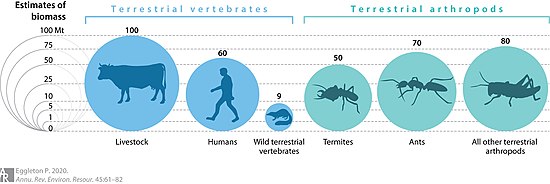
Humans and livestock make up more than 90% of the biomass of all terrestrial vertebrates, and almost as much as all insects combined.[41]
Economic and social benefits

The value of global livestock production in 2013 has been estimated at 883 billion dollars, (constant 2005–2006 dollars).
Livestock provide a variety of food and non-food products; the latter include leather, wool, pharmaceuticals, bone products, industrial protein, and fats. For many abattoirs, very little animal biomass may be wasted at slaughter. Even intestinal contents removed at slaughter may be recovered for use as fertilizer. Livestock manure helps maintain the fertility of grazing lands. Manure is commonly collected from barns and feeding areas to fertilize cropland. In some places, animal manure is used as fuel, either directly (as in some non-Western countries), or indirectly (as a source of methane for heating or for generating electricity). In regions where machine power is limited, some classes of livestock are used as draft stock, not only for
Although livestock production serves as a source of income, it can provide additional economic values for rural families, often serving as a major contributor to food security and economic security. Livestock can serve as insurance against risk[44] and is an economic buffer (of income and food supply) in some regions and some economies (e.g., during some African droughts). However, its use as a buffer may sometimes be limited where alternatives are present,[45] which may reflect strategic maintenance of insurance in addition to a desire to retain productive assets. Even for some farmers in Western nations, livestock can serve as a kind of insurance.[46] Some crop growers may produce livestock as a strategy for diversification of their income sources, to reduce risks related to weather, markets and other factors.[47][48]
Many studies have found evidence of the social, as well as economic, importance of livestock in non-Western countries and in regions of rural poverty, and such evidence is not confined to pastoral and
Social values in developed countries can also be considerable. For example, in a study of livestock ranching permitted on national forest land in New Mexico, US, it was concluded that "ranching maintains traditional values and connects families to ancestral lands and cultural heritage", and that a "sense of place, attachment to land, and the value of preserving open space were common themes". "The importance of land and animals as means of maintaining culture and way of life figured repeatedly in permittee responses, as did the subjects of responsibility and respect for land, animals, family, and community."[52]
In the US, profit tends to rank low among motivations for involvement in livestock ranching.[53] Instead, family, tradition and a desired way of life tend to be major motivators for ranch purchase, and ranchers "historically have been willing to accept low returns from livestock production".[54]
Environmental impact
| Food Types | Greenhouse Gas Emissions (g CO2-Ceq per g protein) |
|---|---|
| Ruminant Meat | 62
|
| Recirculating Aquaculture | 30
|
| Trawling Fishery | 26
|
| Non-recirculating Aquaculture | 12
|
| Pork | 10
|
| Poultry | 10
|
| Dairy | 9.1
|
| Non-trawling Fishery | 8.6
|
Eggs
|
6.8
|
Starchy Roots
|
1.7
|
| Wheat | 1.2
|
| Maize | 1.2
|
Legumes
|
0.25
|
Animal husbandry has a significant impact on the world environment. It is responsible for somewhere between 20 and 33% of the fresh water usage in the world,[56] and livestock, and the production of feed for them, occupy about a third of Earth's ice-free land.[57] Livestock production is a contributing factor in species extinction, desertification,[58] and habitat destruction.[59] Meat is considered one of the prime factors contributing to the current sixth mass extinction.[60][61][62][63] Animal agriculture contributes to species extinction in various ways. Habitat is destroyed by clearing forests and converting land to grow feed crops and for animal grazing (for example, animal husbandry is responsible for up to 91% of the deforestation in the Amazon region[64]), while predators and herbivores are frequently targeted and hunted because of a perceived threat to livestock profits. The newest report released by the Intergovernmental Panel on Climate Change (IPCC) states that between the 1970s and 2000s agricultural emission increases were directly linked to an increase in livestock. The population growth of livestock (including cattle, buffalo, sheep, and goats) is done with the intention of increasing animal production, but in turn increases emissions.[65]
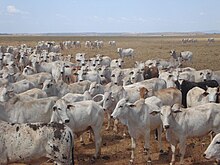
In addition, livestock produce greenhouse gases. The IPCC has estimated that agriculture (including not only livestock, but also food crop, biofuel and other production) accounted for about 10 to 12 percent of global anthropogenic greenhouse gas emissions (expressed as 100-year carbon dioxide equivalents) in 2005[66] and in 2010.[67] Cattle produce some 79 million tons of methane per day.[68][69][70] Livestock enteric methane account 30% of the overall methane emissions of the planet.[68][69][70] Livestock are responsible for 34% of all human-related emissions of nitrous oxide, through feed production and manure.[68][69][70] Livestock offer significant potential for reducing GHG emissions.[68][69][70] Best production practices are estimated to be able to reduce livestock emissions by 30%.[68][69][70]
Impacts of climate change

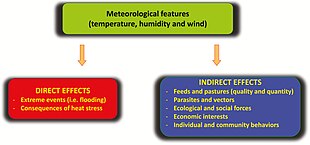
There are numerous interlinked effects of climate change on livestock rearing. This activity is both heavily affected by and a substantial driver of anthropogenic climate change due to its greenhouse gas emissions. As of 2011, some 400 million people relied on livestock in some way to secure their livelihood.[73]: 746 The commercial value of this sector is estimated as close to $1 trillion.[74] As an outright end to human consumption of meat and/or animal products is not currently considered a realistic goal,[75] any comprehensive adaptation to effects of climate change must also consider livestock.
The observed adverse impacts on
While some areas which currently support livestock animals are expected to avoid "extreme heat stress" even with high warming at the end of the century, others may stop being suitable as early as midcentury.
See also
- Agribusiness
- Agroecology
- Amenable species
- Bovine spongiform encephalopathy
- California Proposition 2 (2008)
- Cryoconservation of animal genetic resources
- Cuniculture (rabbit farming)
- Leave the gate as you found it
- Livestock's Long Shadow – Environmental Issues and Options (UN report)
- Pen
- Sericulture (silkworm farming)
- Sheep husbandry
- Western Fair
- Wildlife farming
References
- ^ "livestock". Britannica.com.
- ^ "Congress Clarifies That Horses are Not "Pets," Advances Landmark Livestock Health Measures". American Horse Council. Retrieved 19 January 2019.
- ^ "Fresh Pork from Farm to Table". fsis.usda.gov.
- ^ "NASS – Census of Agriculture – Publications – 2012". USDA. Archived from the original on 22 November 2017. Retrieved 29 November 2017.
- S2CID 39813493.
- ^ "Livestock definition". Dictionary.com. Retrieved 23 November 2015.
- ^ "Merriam-Webster: Definition of Livestock". Merriam-Webster. Retrieved 18 January 2019.
- ^ "Agriculture: A Glossary of Terms, Programs, and Laws" (PDF). 2005. Archived from the original (PDF) on 12 February 2011. Retrieved 10 December 2011.
- ^ cbc.ca: "Police launch investigation into Aylmer Meat Packers", 28 August 2003
- PMID 24453989.
- PMID 19390051.
- PMID 19706455.
- PMID 20404179.
- ^ "Breeds of Livestock - Oklahoma State University". Ansi.okstate.edu. Retrieved 10 December 2011.
- PMID 23530234.
- ^ "History of chickens – India and China". 12 June 2017.
- ^ ISBN 978-1-84971-420-4.
- ^ Blench, Roger (17 May 2001). 'You can't go home again' – Pastoralism in the new millennium (PDF). Overseas Development Institute. p. 12. Archived from the original (PDF) on 1 February 2012. Retrieved 29 April 2018.
- ISBN 978-0-8018-6351-6.
- ISBN 978-0-7619-2598-9.
- ISBN 978-0141-97936-6.
- PMID 18348709.
- ^ Meyer, Vernon M.; Driggers, L. Bynum; Ernest, Kenneth; Ernest, Debra. "Swine Growing-Finishing Units" (PDF). Pork Industry handbook. Purdue University Cooperative Extension Service. Retrieved 17 May 2017.
- ISBN 978-1-4831-9565-0.
- ^ Northern Daily Leader, 20 May 2010, Dogs mauled 30 sheep (and killed them), p.3, Rural Press
- ^ Simmons, Michael (10 September 2009). "Dogs seized for killing sheep - Local News - News - General - The Times". Victorharbortimes.com.au. Archived from the original on 11 January 2012. Retrieved 10 December 2011.
- ^ "EPRUMA | Responsible Use of Animal Medicines". www.epruma.eu. Retrieved 8 February 2020.
- ^ "Classical swine fever" (PDF). The Center for Food Security and Public Health. Retrieved 20 May 2017.
- ^ "Scrapie Fact Sheet". National Institute for Animal Agriculture. 2001. Archived from the original on 12 December 2020. Retrieved 20 May 2017.
- ^ "Foot-and-mouth". The Cattle Site. Retrieved 20 May 2017.
- ^ "feed (agriculture) | Antibiotics and other growth stimulants". Britannica.com. Retrieved 29 April 2018.
- ^ Fraser, Douglas (14 February 2017). "Scottish salmon farming's sea lice 'crisis'". BBC. Retrieved 20 May 2017.
- ^ "Parasite control". Animal Health Ireland. Archived from the original on 14 May 2017. Retrieved 20 May 2017.
- ^ Mbow, C.; Rosenzweig, C.; Barioni, L. G.; Benton, T.; et al. (2019). "Chapter 5: Food Security" (PDF). Special Report on climate change and land (SRCCL).
- ^ Bonser, K. J. (1972). The Drovers. Who They Were and How They Went: An Epic of the English Countryside. Country Book Club.
- ^ Chambers, Philip G.; Grandin, Temple; Heinz, Gunter; Srisuvan, Thinnarat (2001). "Guidelines for Humane Handling, Transport and Slaughter of Livestock | CHAPTER 6: Transport of livestock". Food and Agriculture Organization. Archived from the original on 12 June 2009. Retrieved 29 April 2018.
- ^ "Worker dies, hundreds sick as Cargill temporarily closes meat-processing plant at centre of COVID-19 outbreak". CBC. 21 April 2020.
- ^ a b "What led to Alberta's biggest outbreak? Cargill meat plant's hundreds of COVID-19 cases". CBC. 19 April 2020.
- ^ Markets from research to outcomes Archived 1 May 2014 at WebCite, Farming Matters, Challenge Program on Water and Food, June 2013
- ^ Australian Screen: Agricultural shows
- ^ ISSN 1543-5938.
- ^ FAOSTAT. (Statistical database of the Food and Agriculture Organization of the United Nations.) http://faostat3.fao.org/ Archived 20 October 2016 at the Wayback Machine
- ^ de Haan, Cees; Steinfeld, Henning; Blackburn, Harvey (1997). Livestock & the environment: finding a balance. European Commission Directorate-General for Development.
- ^ a b Swanepoel, F., A. Stroebel and S. Moyo. (eds.) 2010. The role of livestock in developing communities: Enhancing multifunctionality. African Sun Media.
- ISSN 0304-3878. Retrieved 12 May 2018.
- S2CID 54050586. Retrieved 12 May 2018.
- ISSN 0308-521X. Retrieved 12 May 2018.
- ISSN 0921-8009. Retrieved 12 May 2018.
- hdl:10174/9347
- ISSN 1583-1523. Retrieved 12 May 2018.
- ISSN 1018-7081. Retrieved 12 May 2018.
- ^ McSweeney, A. M and C. Raish. 2012. Social, cultural and economic aspects of livestock ranching on the Santa Fe and Carson National Forests. USDA Forest Service RMRS-GTR 276.
- ISSN 0022-409X.
- ^ Torell, L. Allen; Rimbey, Neil R.; Tanaka, John A.; Bailey, Scott A. (2001). "THE LACK OF A PROFIT MOTIVE FOR RANCHING: IMPLICATIONS FOR POLICY ANALYSIS". In Torell, L. A.; Bartlett, E. T.; Larranaga, R. (eds.). Current issues in rangeland economics. Proc. Symp. Western Regional Coordinating Committee on Rangeland Economics: WCC-55. N. M. State Univ. Res. Rep. Vol. 737. Archived from the original on 19 December 2018. Retrieved 30 November 2018.
- S2CID 4453972.
- ^ Mekonnen, Mesfin M.; Arjen Y. Hoekstra (2012). "A Global Assessment of the Water Footprint of Farm Animal Products" (PDF). Water Footprint Network. Archived from the original (PDF) on 2015-03-11. Retrieved 2018-04-01.
- ^ "Livestock a major threat to environment". Food and Agriculture Organizations of the United Nations. Archived from the original on 2008-03-28. Retrieved 2018-04-01.
- ISBN 978-0-12-747261-4.
- ^ "Biodiversity Decline". Annenberg Learner. Retrieved 8 February 2020.
- .
- PMID 26231772.
- S2CID 7771527.
- ^ Smithers, Rebecca (5 October 2017). "Vast animal-feed crops to satisfy our meat needs are destroying planet". The Guardian. Retrieved 3 November 2017.
- ISBN 978-0-8213-5691-3.
- ^ IPCC. (2022). Chapter 7: Agriculture, Forestry, and Other Land Uses. ICPCC AR6 WGII. 7-34. https://report.ipcc.ch/ar6wg3/pdf/IPCC_AR6_WGIII_FinalDraft_Chapter07.pdf Archived 2022-10-10 at the Wayback Machine.
- Fourth Assessment Report
- Fifth Assessment Report.
- ^ a b c d e "Global emissions from livestock in 2015". FAO - GLEAM v3.0 dashboard.
- ^ a b c d e Reducing enteric methane for improving food security and livelihoods. FAO. 2016.
- ^ ISBN 9789251079201.
- ^ PMID 24692268.
- PMID 32002236.
- ^ a b c d e f g Kerr R.B., Hasegawa T., Lasco R., Bhatt I., Deryng D., Farrell A., Gurney-Smith H., Ju H., Lluch-Cota S., Meza F., Nelson G., Neufeldt H., Thornton P., 2022: Chapter 5: Food, Fibre and Other Ecosystem Products. In Climate Change 2022: Impacts, Adaptation and Vulnerability [H.-O. Pörtner, D.C. Roberts, M. Tignor, E.S. Poloczanska, K. Mintenbeck, A. Alegría, M. Craig, S. Langsdorf, S. Löschke,V. Möller, A. Okem, B. Rama (eds.)]. Cambridge University Press, Cambridge, United Kingdom and New York, NY, US, pp. 1457–1579 |doi=10.1017/9781009325844.012
- ^ "FAOStat". Archived from the original on 2016-10-20. Retrieved 12 June 2023.
- S2CID 239376124.
- S2CID 256256647.
- .
- S2CID 201103432.
- S2CID 258751271.
- ^ Lisa O'Carroll (3 November 2021). "Ireland would need to cull up to 1.3 million cattle to reach climate targets". The Guardian. Retrieved 12 June 2023.
- ^ "just-transition-meat-sector" (PDF).
External links
- Better Lives Through Livestock by ILRI
- Livestock - New South Wales Government
- Havana Livestock Fair (Photo Feature) - Havana Times, 19 October 2010
- A Short History of Livestock Production
- Have we reached ‘peak meat’? Why one country is trying to limit its number of livestock. The Guardian. 16 January 2023


